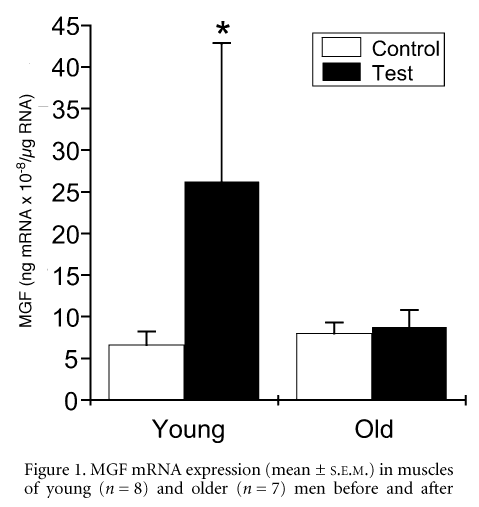Muscle mass is lost in later life and the mechanisms underlying this phenomenon remain unclear. It is possible that older muscles are less sensitive to mechanical signals. Skeletal muscle is known to express at least two isoforms of IGF-I and it has been reported that in response to overload the muscles of aged rats are less able to upregulate the splice variant of IGF-I termed MGF (Owino et al. 2001). In the present study, approved by the local ethics committee, we aimed to determine whether there were any age-related differences in MGF mRNA expression in human muscle shortly after a bout of high resistance exercise.
Following prior determination of the maximum one-legged knee extensor lift (1-RM) at least 1 week before the experimental day, eight healthy young (26Ð36 years) and seven healthy older (70Ð82 years) men performed ten sets of six repetitions of knee extensor exercise, lifting and lowering a mass equal to 80 % of their 1-RM. Two minutes passive recovery was given between each set. Following local anaesthesia (1 % lignocaine), muscle biopsies were obtained from the vastus lateralis muscle of the exercised (test) and non-exercised (control) legs 2.5 h after the end of the exercise session using the needle technique. Samples were immediately frozen. Subsequent quantification of the mRNA of the two IGF-I isoforms in muscle (MGF and IFG-IEa) was performed using a quantitative reverse transcription-polymerase chain reaction (RT-PCR) method (LightCycler, Roche UK).
The mean (± S.E.M.) 1-RM for the young subjects was 41.9 ± 4.3 versus 20.6 ± 1.6 kg for the older subjects (P < 0.05). When normalised to total RNA content, levels of IGF-IEa were not different different between the young and old subjects (6.3 ± 0.9 versus 6.9 ± 1.0 X 10-5 ng mRNA/µRNA) and no change was observed as a result of the exercise bout. MGF mRNA levels at rest were lower than those of IGF-IEa, but were also not different between the young and old subjects (Fig. 1). In the young subjects, a significantly higher level of MGF was observed in the test leg when compared with the control leg (P < 0.05). However, no difference was observed between the test and control legs in the elderly subjects.
These data show that following a standardised bout of high resistance weight-lifting exercise, there is an age-related difference in MGF gene expression. The data in young subjects also suggest that the MGF and IGF-IEa isoforms are differentially regulated in human skeletal muscle.
The finanical support of REMEDI and the European Union (Framework V) is gratefully acknowleged. S.D.R.H. is a Wellcome Trust Research Fellow.
All procedures accord with current local guidelines and the Declaration of Helsinki.

